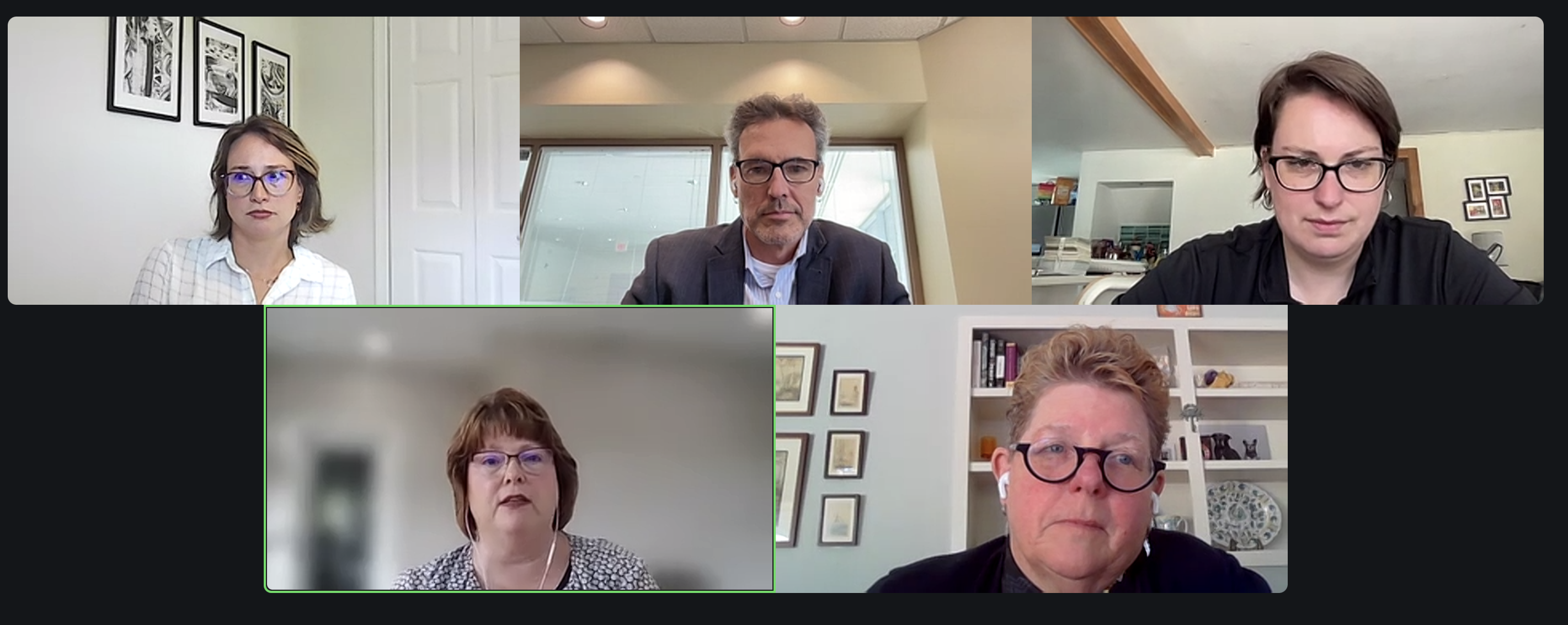Investing in Employees: Insights from the Business of Light Webinar
The recent Business of Light (BOL) webinar explored a critical aspect of running a successful organization: investing in your employees. This in-depth discussion featured experts in HR, leadership, and lighting design, who offered diverse perspectives on strategies for building engagement, navigating the modern workplace, and creating an inclusive environment.

BOL Panel Discussion Featuring: Annie Hess, Aram Ebben, Sara Schonour, Charlene Miraglia and Jane White
The panel was hosted by The Business of Light and moderated by their Director of Education, Sara Schonour of Luxsi, and included:
- Annie Hess: HR Leader with 15 years of experience in total rewards and talent acquisition from George Washington University.
- Aram Ebben: Principal and Director of Lighting Design at EXP, Inc., with nearly 30 years of experience in architectural lighting design.
- Jane White: Chief Diversity and Engagement Officer at Legrand North and Central America, and former President of Finelite.
- Charlene Miraglia: Human Resources Director at Cannon Design, who focuses on creating a people-centered workplace.
Setting the Stage: The Importance of Professional Development
Sara Schonour began the discussion by emphasizing the raison d’etre for the BOL: “The mission of the Business of Light is to empower individuals across the industry—whether on the design side, representing agencies, or beyond—to grow and sustain their businesses,” she said. By promoting stronger business acumen across all sectors, the initiative aims to build a more resilient industry. The Business of Light’s board of directors, made up of a diverse group of designers, reps, manufacturers, and retired professionals, shares this vision.

BOL Upcoming Events
Special recognition was given to ALR for becoming the BOL’s newest Founder Circle member. Their support, along with the 15 other founder’s circle members, is vital for upcoming sessions and workshops, like the upcoming September line-up:
- “Revit to Reality” roadshow, set to visit cities like Nashville on 11 September and Anaheim, California, on 19 September: Learn about how and when the different players in the lighting industry make their money, and how to collaborate for the best outcomes.
- “Passion, Power, Precision” An immersive full-day workshop on September 16th in NYC and 18 September in San Francisco.
Next, Schonour presented the topic of the day: investing in employees as a contribution to business success. “Investing in your employees through education and opportunities like these workshops is a powerful way to build a stronger, more engaged team,” said Sara. “It’s not just about enhancing skills but also about creating a culture of growth within your company.”
Defining Employee Engagement: What It Means and How to Measure It
Charlene Miraglia explained the core of employee engagement: “Employee engagement is the strength of the mental and emotional connection someone has towards their work, their team, and their organization. Studies consistently show that higher engagement leads to better client satisfaction, which is crucial for long-term business success.”
She also described two key ways to measure engagement: surveys and conversations. “Surveys, whether full-scale or quick pulse surveys, provide data, but conversations with employees—both individually and in groups—are vital for truly understanding what’s going on. While engagement scores show results, the real work is in addressing the factors behind those numbers.”
Annie Hess added that engagement starts with providing employees with clear expectations and the resources they need. “Employees need to know how their work connects to the company’s mission and have the tools to do their job well. Engagement thrives when these basics are in place.”
Spotting and Addressing Signs of Disengagement
The panel also discussed how to identify disengagement early and steps leaders can take to re-engage their teams. Jane White stressed the importance of clarity and consistent communication. “Disengagement often starts when there’s ambiguity—whether in values, expectations, or communication. When employees feel uncertain or excluded, especially if changes occur without their involvement, disengagement can quickly set in.”
Aram Ebben shared his experience managing remote teams. “Keeping everyone connected, no matter where they are, is key. We hold regular check-ins, but those need to go beyond just touching base. It’s about asking meaningful questions like, ‘What’s happening in your world?’ or ‘How can I support you?’ Without these conversations, you might miss the early signs of disengagement.”
Charlene reinforced the need for intentional engagement, especially in remote work setups. “In a remote environment, casual drop-ins aren’t possible. You need to make time to connect intentionally. It’s not just about formal meetings—it’s about creating space for genuine conversations.”
Delivering Feedback and Encouraging Growth
The conversation then shifted to how feedback should be delivered and how it contributes to professional growth. Annie emphasized the importance of giving feedback continuously. “Feedback shouldn’t be saved for the end of the year. When someone does something well, tell them immediately. And if something needs improvement, address it while it’s still fresh. The goal is to build on what’s working and quickly correct what isn’t.”
Jane suggested reframing the concept of “feedback” instead as “feedforward” to focus on future growth instead of past mistakes. “Marshall Goldsmith’s idea of feedforward is effective because it looks ahead. It’s about helping people use their strengths and continue growing, rather than dwelling on what went wrong. This approach encourages continuous development.”
Aram described his practice of celebrating wins publicly while handling improvement discussions privately. “When someone does something great, everyone hears about it. Those achievements deserve recognition. But when it comes to performance critiques, those are best handled one-on-one. It’s about creating a supportive environment where feedback helps people grow.”
Professional Development: Investing in Employees
The panel agreed that professional development is one of the best investments a company can make in its employees. Aram spoke about offering employees the freedom to choose their growth paths. “We provide a budget and let team members decide how to spend it—whether on conferences, classes, or certifications. The key is aligning these opportunities with both company goals and personal aspirations. It’s about giving employees control over their development.”
Annie added that development isn’t limited to formal training. “Some of the best growth happens through on-the-job experiences. Assigning someone to a challenging project, offering a stretch role, or involving them in a steering committee can be just as impactful as sending them to a class. It’s about recognizing potential and pushing people out of their comfort zones.”
Charlene stressed the importance of transparency in development opportunities. “Employees need to see that their growth is supported and that there’s a clear path forward. It’s also important to be transparent about why certain opportunities are prioritized and how those decisions fit into the company’s broader objectives.”
Flexibility in the Modern Workplace
The discussion then turned to the evolving landscape of work and the balance between flexibility and maintaining strong relationships. Annie highlighted the challenge of balancing diverse needs across the workforce. “Flexibility is vital for job satisfaction, but there’s no one-size-fits-all solution. Some roles need more on-site presence, while others don’t. The key is explaining why decisions are made and being open to feedback.”
Jane acknowledged the benefits and challenges of flexibility. “Flexibility is empowering, but it can also be isolating. Employees may be captains of their own ships, but they might feel alone on that ship. Building intentional connections—whether through virtual events, regular check-ins, or occasional in-person meetings—helps create a sense of belonging.”
Aram discussed the importance of in-person learning for junior employees. “For new designers, being in the office is crucial for absorbing knowledge from experienced colleagues. We need to be intentional about creating those learning moments. If we ask people to come in, there needs to be a clear purpose behind it.”
The conversation touched on diversity of workforce and the similarly diverse needs, and how that’s showing up in tailored benefits packages and new focuses on employee support structures, and employers can support their employees by learning about their preferences, needs, and challenges to design unique solutions instead of one size fits all.
Diversity, Equity, and Inclusion: A Foundation for Success
Jane passionately addressed the role of diversity, equity, and inclusion (DEI) in the workplace. “Diversity is more than a checkbox. It’s about harnessing the full range of perspectives within your workforce. That’s where true innovation happens. But having diversity isn’t enough—you need an inclusive culture where everyone feels valued and heard. That’s what keeps people engaged and committed.”
Charlene emphasized that inclusion starts with self-awareness. “Understanding your biases is the first step. Leaders need to examine how their behaviors and decisions impact others. Creating a psychologically safe environment where employees can speak up without fear is essential for fostering inclusion.”
Leadership with Emotional Intelligence: IQ, EQ, and DQ
The panel concluded with a discussion on emotional intelligence (EQ) and its role in leadership. Annie explained how EQ directly affects engagement. “When employees feel valued and respected, they’re more engaged. Emotional intelligence helps leaders build those connections. It’s about listening, showing empathy, and genuinely caring about both professional and personal well-being.”
Jane introduced the concept of the “decency quotient” (DQ), adding a new dimension to the discussion. “IQ and EQ are important, but DQ—decency quotient—is what sets great leaders apart. It’s about showing a genuine desire to do right by your employees. Leaders who consistently show decency build trust and loyalty.”
Charlene summarized the overall message: “It’s about staying intentional, transparent, and continuously learning. When we do that, we create workplaces where employees feel valued, supported, and motivated to bring their best selves to work every day.”




